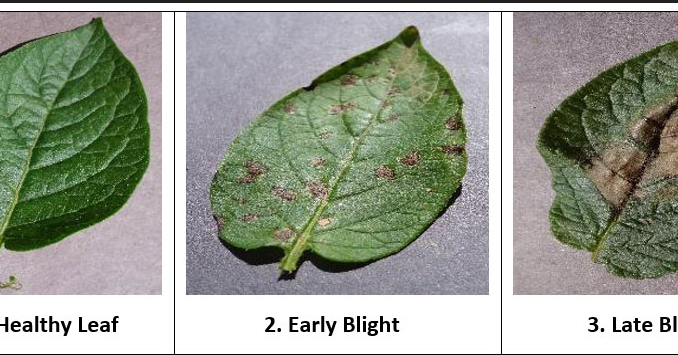
This is a simple image classification project using VGG16 pretrained architecture for classifying Potato leaf diseases
This project focuses on building an image classification model using the VGG16 architecture to classify images into three distinct classes. The dataset is divided into training, validation, and test sets, with images preprocessed and augmented using ImageDataGenerator. The VGG16 model, pre-trained on ImageNet, is fine-tuned by adding custom dense layers and trained with early stopping criteria to prevent overfitting. The model’s performance is evaluated on the test set, achieving high accuracy, and a method is implemented to predict the class of new images from their file paths. This project demonstrates effective transfer learning for image classification tasks.
Folder structure
Import Libraries
import tensorflow as tf
from tensorflow.keras.preprocessing.image import ImageDataGenerator
from tensorflow.keras.applications import VGG16
from tensorflow.keras.layers import Dense, Flatten, Dropout
from tensorflow.keras.models import Model
from tensorflow.keras.optimizers import Adam
from tensorflow.keras.callbacks import EarlyStopping
Data Preprocessing and Augmentation
train_dir = 'path/to/train'
val_dir = 'path/to/val'
test_dir = 'path/to/test'# Image Data Generators
train_datagen = ImageDataGenerator(rescale=1.0/255.0)
val_datagen = ImageDataGenerator(rescale=1.0/255.0)
test_datagen = ImageDataGenerator(rescale=1.0/255.0)
train_generator = train_datagen.flow_from_directory(
train_dir,
target_size=(224, 224),
batch_size=32,
class_mode='categorical'
)
val_generator = val_datagen.flow_from_directory(
val_dir,
target_size=(224, 224),
batch_size=32,
class_mode='categorical'
)
test_generator = test_datagen.flow_from_directory(
test_dir,
target_size=(224, 224),
batch_size=32,
class_mode='categorical'
)
Load VGG16 Model and Add Custom Layers
# --------------- Load the VGG16 model pre-trained on ImageNet, excluding the top (fully connected) layers. --------------
base_model = VGG16(weights='imagenet', include_top=False, input_shape=(224, 224, 3))# ------- Add custom fully connected layers on top of the VGG16 base. ---------------------
x = base_model.output
x = Flatten()(x)
x = Dense(512, activation='relu')(x)
x = Dropout(0.5)(x)
predictions = Dense(3, activation='softmax')(x) # Assuming 3 classes
model = Model(inputs=base_model.input, outputs=predictions)
Freeze Base Layers: Freeze all layers in the VGG16 base model to prevent them from being updated during the training.
for layer in base_model.layers:
layer.trainable = False
Compile the model
model.compile(optimizer=Adam(learning_rate=1e-4),
loss='categorical_crossentropy',
metrics=['accuracy'])
Add Early stopping Callback to stop the training when it achieves optimal validation accuracy , This is mainly to prevent the overfitting of the model and to make the model more generalized
early_stopping = EarlyStopping(
monitor='val_accuracy',
patience=5, # Stops training when there is no change for first 5 consecutive validation accuracy values
verbose=1,
mode='max',
restore_best_weights=True
)
Train the model
history = model.fit(
train_generator,
steps_per_epoch=train_generator.samples // train_generator.batch_size,
validation_data=val_generator,
validation_steps=val_generator.samples // val_generator.batch_size,
epochs=100, # Set a high number for epochs; early stopping will handle stopping early.
callbacks=[early_stopping]
)
Evaluate and Save the model
# Evaluate the Model
test_loss, test_accuracy = model.evaluate(test_generator, steps=test_generator.samples // test_generator.batch_size)
print(f'Test accuracy: {test_accuracy}')# Save the Model
model.save('vgg16_image_classification_model.h5')
Testing The model
Create Class label dictionary
import jsonclass_indices = {v: k for k, v in train_generator.class_indices.items()} # Get class labels
with open("class_names.json","w") as f:
json.dump(class_indices,f,indent=4)
Test Code
import cv2
import json
import os
import numpy as np
from tensorflow.keras.preprocessing.image import load_img,img_to_array
from tensorflow.keras.models import load_modelmodel_path="vgg16_image_classification_model.h5"
model=load_model(model_path)
with open("class_names.json") as f:
class_dict=json.load(f)
test_image_path=r"Data" # Add your image Path here
image_obj=cv2.imread(test_image_path)
test_image=cv2.resize(image_obj,(224, 224))
#==========Convert image to numpy array and normalize ==========
test_image=img_to_array(test_image)/255
#=======================change dimention 3D to 4D ==============
test_image=np.expand_dims(test_image,axis=0)
result=model.predict(test_image)
pred=np.argmax(result,axis=1)
predicted_val=int(pred)
predicted_disease=class_dict[str(predicted_val)]
print("Disease : ",predicted_disease)

Be the first to comment